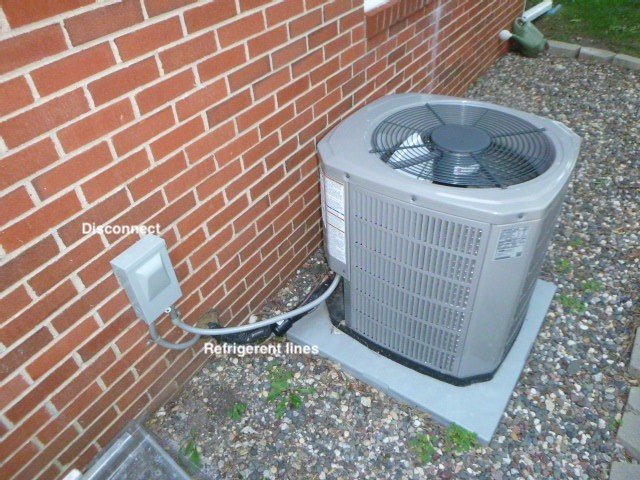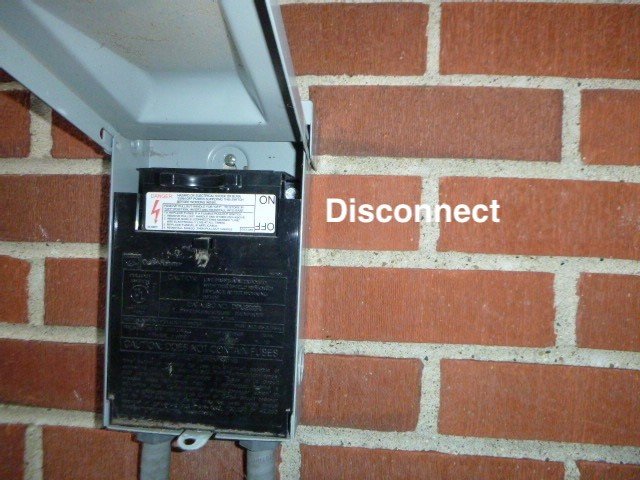Inspecting air conditioners during a home inspection and what a home inspector does can sometimes be misunderstood. Using the Standards of Practice (SOP) set forth by InterNACHI, we will try to explain the process and hopefully clarify the difference between testing at a home inspection and what a service person does when servicing an air conditioning system.
Air Conditioning Unit Sitting on a Pad
Section 3.5: Cooling from the SOP
I. The inspector shall inspect:
the cooling system, using normal operating controls.
II. The inspector shall describe:
the location of the thermostat for the cooling system; and
the cooling method.
III. The inspector shall report as in need of correction:
any cooling system that did not operate; and
if the cooling system was deemed inaccessible.
IV. The inspector is not required to:
determine the uniformity, temperature, flow, balance, distribution, size, capacity, BTU, or supply adequacy of the cooling system.
inspect portable window units, through-wall units, or electronic air filters.
operate equipment or systems if the exterior temperature is below 65° Fahrenheit or when other circumstances are not conducive to safe operation or may damage the equipment.
inspect or determine thermostat calibration, cooling anticipation, or automatic setbacks or clocks.
examine electrical current, coolant fluids or gases, or coolant leakage.
Normal operating conditions
To start with, we need to make sure that the air conditioning unit is warm enough. The external temperature needs to be at least 65 degrees for a minimum of 24 hours. This is important because there is potential to damage the condensing unit if it is operated at temperatures that are below 65 degrees.
Unfortunately, here in Minnesota, there are some years when we cannot physically run air conditioners from late fall into late spring. This is as frustrating for us as it is for the people we are doing the home inspections for. If the temperatures do not meet operating criteria, we document in the inspection report that we were unable to fully inspect.
If the air conditioner is not already set and running, your home inspector will switch the thermostat to cool mode to engage the system. The home inspector will document whether there is a single thermostat or multizone and whether or not the thermostat is programmable or not.
The type of system present
The type of air conditioning system is documented in your inspection report. Typically, in our region, air conditioners are either a central air conditioning system, a window or wall unit, or a small split system.
The location of the air conditioning unit on the exterior of the home is documented. There are several things that we look at on the exterior. When the unit is running, we make note of whether there are any unusual noises, vibrations, etc.
Ensure the air conditioning unit is sitting level
The bearings in the compressor and fan of the condensing unit are designed to run in a vertical position. If your air conditioner is sitting on a pad that has settled, there will be a radial load on the bearings that may cause premature wear. Any unevenness will be documented as in need of correction.
Proper operational clearances
The compressor unit should have a minimum of 12 inches of clearance on all sides and be unobstructed above the unit. This allows for the fan to adequately pull air through the cooling coils from the sides and blow it up and out of the top.
The home inspection report will document any vegetation that needs to be cut back, debris such as grass clippings or dryer lint, and any damaged cooling fins in need of repair.
Refrigerant lines
There are two lines running from the external condensing unit back to the air handler and cooling coil. One of them has no insulation and is called the high-pressure line, and if the unit is running, this line will be very hot. The refrigerant line, or suction line, is very cold and runs to the cooling coil. It should be completely covered with insulation. Any missing or damaged insulation will be documented as in need of repair.
Air Conditioning Condensing Unit
Electrical Disconnect and Refrigerant Lines are Labeled
Electrical
An electrical disconnect is required within sight of the condensing unit. This disconnect allows a service person to safely remove power from the condensing unit while servicing. The type of disconnect will be documented in your home inspection report. Any damage or lack of a disconnect will be documented as in need of repair.
Tumble Switch” Electrical Disconnect
Your home inspector will also look at the data plate on the side of the unit to determine the minimum and maximum amperage. For example, if the data plate indicates a maximum 30-amp breaker, we will confirm the breaker in the electrical panel. For example, we occasionally see in older homes where the data plate on a newer air conditioner indicates a maximum 20-amp breaker. However, when we inspect the electrical panel, we find a 30- or 40-amp breaker, which may have been the requirement for a much older unit. This defect would be documented as in need of repair.
Data Plate Showing a Maximum of a 30-amp Fuse or Breaker
Supply and return registers
Once we're in the house and the air conditioning unit has been running for a while, we check the supply and return vents to confirm that the air conditioning is running properly. There should be a difference in temperature of 14 to 21 degrees between the air blowing into a room and the air being sucked out of the room. Anything outside of that range indicates that the air conditioner is not functioning properly. The caveat here is that if it's 70 degrees outside and 72 degrees inside, we may not get that 14- to 21-degree difference between the two temperatures. Your home inspector needs to take this into consideration when taking these measurements.
Furnace/air handler
When at the furnace, we look to see that there is a condensate drain line and that it is properly routed to a drain or a miniature sump pump. The condensate line takes the moisture that is removed from the air at the cooling coil and drains it from a catch tray. Any corrosion on the air handler chassis or water on the floor around the furnace would indicate the condensate line is plugged and the water is overflowing. Some furnaces, such as the one below, have a condensate overflow alarm installed.
Furnace/Air Conditioner Air Handler
Summary
As you can see, there is quite a bit that goes into inspecting an air conditioner during the process of a home inspection. This is primarily a visual inspection and is not 100% technically exhaustive. Our best recommendation to keep your air conditioner running at peak performance is to have annual checkups performed by a reputable HVAC company. They have tools and techniques that go above and beyond our standard practice.
At HomePro Inspections, our home inspectors are trained to inspect all areas of the home. Any issues found are documented in your home inspection report and recommended for resolution by a qualified professional.
Visit our website to learn more or to schedule your home inspection in the Rochester, Owatonna, and Faribault, MN areas. You can contact us today at (507) 202-8942 or utilize our online “Schedule Now” feature to set up an appointment.





